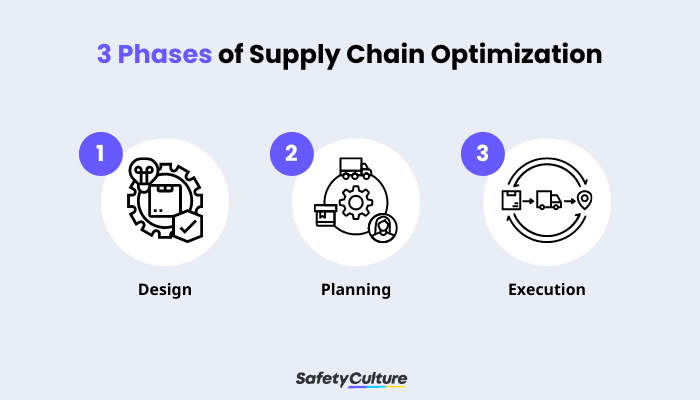What is Supply Chain Optimization?
Supply chain optimization refers to the process of strategically managing and improving various elements within a supply chain to enhance efficiency, reduce costs, and maximize overall performance. It involves analyzing and optimizing the entire supply chain network, from the procurement of raw materials to the delivery of finished products or services to end customers in a cost-effective and timely manner. Through supply chain optimization, organizations can improve overall competitiveness and customer satisfaction.
Importance
Implementing optimization in Supply Chain Management (SCM), when done right, brings various benefits to organizations. For the following reasons, supply chain stakeholders must prioritize the integration of strategies and tools to streamline their operations:
Operational Efficiency and Cost Reduction
Efficient supply chain management ensures that resources are utilized optimally, reducing excess inventory and associated holding costs, transportation expenses, and production delays. By optimizing processes, minimizing waste, and enhancing overall coordination among different supply chain elements, organizations can achieve cost savings and improve their bottom line. These help enhance organizations’ competitiveness in the market, allowing them to offer better value to customers.
Customer Satisfaction
As customer demands continually evolve, organizations must be agile and responsive. By optimizing the supply chain, companies can better align their production and distribution processes with changing consumer preferences, reducing lead times and improving delivery speed. This agility is crucial in building brand loyalty, as customers increasingly value reliability and timely delivery as integral components of their overall experience.
Risk Management
A well-optimized supply chain allows organizations to diversify their suppliers, strategically position inventory, and implement contingency plans, thereby mitigating potential disruptions. This resilience is also critical for maintaining business continuity and safeguarding against unforeseen events, ensuring that organizations can adapt to challenges and continue to meet market demands effectively.
Key Features of Supply Chain Optimization
Over the years, the optimization of supply chain processes has become imperative for organizations aiming to stay competitive and responsive to market demands. The following key features must be taken into consideration to achieve an efficiently managed and streamlined supply chain:
1. Visibility
Supply chain visibility provides real-time insights into the entire lifecycle of products, from raw materials to the end customer. It involves tracking and monitoring inventory levels, production status, and transportation movements, among others.
Improved visibility enables better coordination among stakeholders, reduces the risk of disruptions, and enhances the overall responsiveness of the supply chain.
2. Intelligence
The integration of advanced technologies like Artificial Intelligence (AI) and machine learning helps analyze vast amounts of data to provide valuable insights for informed decision-making. From demand forecasting to route optimization, intelligence enhances efficiency, reduces costs, and contributes to a more agile and adaptive supply chain.
3. Order Management
Efficient order management involves the seamless processing of orders from initiation to fulfillment, minimizing errors and enhancing customer satisfaction. At its base level, an optimized order management system streamlines the order-to-cash cycle, ensuring that products reach customers in a timely manner and fostering a responsive and customer-centric supply chain.
4. Reporting and Analytics
By providing in-depth insights into performance metrics, trends, and areas for improvement, reporting and analytics tools empower organizations to make data-driven decisions. Continuous evaluation and refinement based on analytics then contribute to the ongoing improvement of supply chain processes.
Scale Your Enterprise Operations with Customizable Solutions
✓ Scale ✓ Data ✓ Security ✓ Integration ✓ Teams
Learn More5. Inventory Tracking
Effective inventory tracking prevents stockouts, minimizes excess inventory, and ensures efficient use of storage space. Inventory tracking systems also contribute to accurate demand planning, reducing carrying costs and ensuring that products are available when and where they are needed within the supply chain.
What are the Three Phases of a Supply Chain Optimization Process?

3 Phases of Supply Chain Optimization
Organizations engage in a systematic process of optimizing supply chain operations. This typically unfolds in three distinct phases, each playing a crucial role in transforming and refining the entire ecosystem. Diving deeper into each stage, here’s how an overall supply chain optimization can run:
1. Design
The design phase involves conceptualizing and structuring the entire supply chain network, taking into consideration factors such as supplier relationships, distribution channels, and technology integration.
During this phase, organizations strategize the most efficient layout, identifying key touchpoints for improvement. The aim is to create a blueprint that aligns with the business goals, enhances flexibility, and establishes a foundation for subsequent optimization efforts.
2. Planning
Following the design phase, the planning stage deals with developing comprehensive strategies for procurement, production, and distribution. Demand forecasting becomes a critical aspect, ensuring that the supply chain is equipped to meet market requirements in a timely and cost-effective manner.
In this phase, organizations also fine-tune inventory management, supplier relationships, and risk mitigation strategies.
3. Execution
The execution phase brings the carefully laid plans into action by implementing the strategies and operational changes outlined in the design and planning phases. Efficient execution requires seamless coordination across all elements of the supply chain, from procurement and manufacturing to distribution and delivery.
Also, real-time monitoring and adaptability are key in this phase, allowing organizations to promptly address challenges, optimize processes, and ensure that the supply chain functions at its peak performance.
Following that, continuous assessments and adjustments must be conducted to align with evolving market dynamics and organizational goals.
Best Practices
Successful supply chain optimization involves adopting strategic measures that enhance visibility and promote adaptability to allow organizations to navigate complexities and deliver value to customers.
Hence, they must follow these best practices for supply chain management optimization:
- Leverage advanced technologies, such as AI, Internet of Things (IoT), and data analytics, to enhance visibility, automate processes, and gain actionable insights.
- Foster strong collaboration and communication with suppliers, distributors, and other stakeholders to align goals, share crucial information, and mitigate risks collectively.
- Ensure accurate and transparent data throughout the supply chain to avoid errors, and reduce costly delays.
- Adopt lean inventory management principles to minimize excess stock and carrying costs, improve cash flow, and enhance responsiveness to market demands.
- Encourage feedback from stakeholders, monitor Key Performance Indicators (KPIs), and implement iterative improvements.
- Invest in training programs, technology education, and cross-functional collaboration to equip employees with the skills necessary to ensure well-optimized supply chain operations.
- Diversify suppliers, establish contingency plans, and regularly assess vulnerabilities to build resilience into the supply chain, allowing organizations to manage unforeseen disruptions and maintain business continuity.
Examples and Use Cases
Here are a few illustrative examples that highlight the diverse applications of supply chain optimization in various industries and use cases:
Demand Forecasting and Inventory Management
A retail company utilizes advanced forecasting models and analytics to predict consumer demand for its products accurately. By leveraging historical data, market trends, and seasonality patterns, the company optimizes inventory levels, ensuring that stock aligns with anticipated demand.
This proactive approach minimizes overstocking, reduces carrying costs, and enhances the ability to meet customer demands promptly.
Route Optimization for Logistics
A logistics company integrates route optimization algorithms into its strategies for streamlining delivery processes. By considering factors such as traffic patterns, delivery windows, and fuel efficiency, the company optimizes the routes taken by its vehicles. This not only reduces transportation costs but also enhances on-time deliveries, improving customer satisfaction and overall supply chain efficiency.




